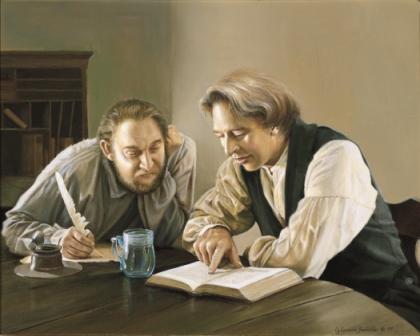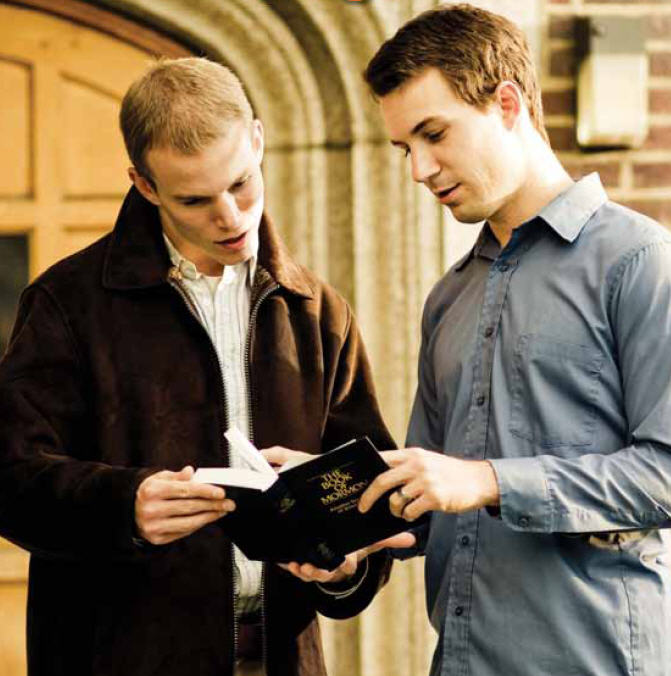To accompany your Come Follow Me study for April 21-27
In addition to reading these four sections, you will also want to:
- Saints, 1:109-111, at https://www.churchofjesuschrist.org/study/history/saints-v1/10-gathered-in?lang=eng
- “Voices of the Restoration,” at the end of this week’s Come Follow Me lesson material.
- “Joseph Smith Translation of the Bible,” at https://www.churchofjesuschrist.org/study/history/topics/joseph-smith-translation-of-the-bible?lang=eng
- Chapter 14: Doctrine and Covenants 35–36; 39–40 (churchofjesuschrist.org)
- Chapter 15: Doctrine and Covenants 37–38; 41 (churchofjesuschrist.org)
- Joseph Smith’s Revelations, Doctrine and Covenants 37 (churchofjesuschrist.org)
- Joseph Smith’s Revelations, Doctrine and Covenants 38 (churchofjesuschrist.org)
- Joseph Smith’s Revelations, Doctrine and Covenants 39 (churchofjesuschrist.org)
- Joseph Smith’s Revelations, Doctrine and Covenants 40 (churchofjesuschrist.org)
- ‘Go to the Ohio’ (churchofjesuschrist.org)
- James Covel and the ‘Cares of the World’ (churchofjesuschrist.org)
- See any or all of the following videos:
If you would like a Kahoot game relating to this information which you could use with your family or class, click here: https://create.kahoot.it/share/doctrine-and-covenants-37-40/195ba3c1-4739-480c-af21-3da8fd7ae710. To use it with a group, after clicking on this link, you will need to log into Kahoot, creating a free account if you have not done so previously, then click on the blue “Host Live” button or the gray “Assign” button, depending on how you wish to use the Kahoot. Some of the Kahoot questions may presuppose that the player has read through the suggested answers to the following Points to Ponder and at least has browsed the Institute student manual as well.
Points to Ponder in Doctrine and Covenants 37-40
1. What reasons does the Lord give for asking the New York saints to move to Ohio? What additional reason(s) can you think of for which the Lord would have wanted them to go?
2. How can we apply the principle of gathering in our lives today, even though we aren’t commanded to move to one central location?
3. What relationship can you see between the work Joseph Smith and Sidney Rigdon had been doing on the inspired “translation” of the Bible and the content of D&C sections 37-40? What additional light did D&C 38 in particular reveal?
4. In what respects is the word “translation” a misnomer for what Joseph Smith and Sidney Rigdon were doing? What would be a better term for it?

5. Why doesn’t the Church use the Joseph Smith Translation exclusively rather than use translations produced by non-Latter-day Saints as our primary Bible versions?
6. Doctrine and Covenants 38:27 states, “Be one; and if ye are not one ye are not mine.” What does it mean for the Church and its members to be “one”? What are some practical ways we can foster unity in our wards, families, and other groups?
7. In Doctrine and Covenants 38:30, the Lord says, “If ye are prepared ye shall not fear.” What kinds of preparation (spiritual, temporal, etc.) were the early Saints asked to make in anticipation of the move to Ohio? How can we apply this principle of preparation to overcome fear in our own lives as we face uncertainties?
8. In Doctrine and Covenants 38:39, the Lord speaks of the “riches of eternity.” What do you understand these riches to be? How can seeking these eternal riches influence our priorities and actions in this life?
9. What are the main lessons we learn from the James Covel experience?

Identify passages in this week’s reading which teach or imply each of the following ideas:
10. The Lord gives a commandment which he repeats, evidently for emphasis, in the following verse.
11. God is more patient than his angels.
12. Preparation prevents panic.
13. No national governments as we now know them will endure beyond the Second Coming of Christ.
14. The Lord put enough natural resources on this planet that everyone potentially could be rich if mankind used those resources properly.
15. Possible hint of a future civil war in the US
16. Latter-day Saints as a group are destined to be the richest people on earth, both temporally and spiritually
17. Early introduction of the “every member a missionary” idea

18. The righteous should be looking for the signs of the Savior’s Second Coming.
19. What other passages did you find especially inspiring or noteworthy in this week’s reading, and why?
Possible Answers to Points to Ponder in Doctrine and Covenants 37-40
1. What reasons does the Lord give for asking the New York saints to move to Ohio? What additional reason(s) can you think of for which the Lord would have wanted them to go?
- To escape the power of “the enemy,” which threatened their lives (37:1; 38:13, 28, 31)
- There He would give them his “law” (38:32)
- There He would endow them “with power from on high” in the future Kirtland Temple (38:32)
- It would become the Church center from which missionaries would go forth (38:33)
- There were more members in Ohio than in New York, with many more to come from that area, and they very much needed leadership which the New York saints could provide.
2. How can we apply the principle of gathering in our lives today, even though we aren’t commanded to move to one central location?
Today, we gather in our wards and stakes, at the temple, and in our families. The blessings are similar: increased strength, mutual support, spiritual growth, and feeling the Spirit. Such modern means of communication as the Internet, satellite transmissions, and Zoom technology älso facilite a “gathering” even of those geographically separate.
3. What relationship can you see between the work Joseph Smith and Sidney Rigdon had been doing on the inspired “translation” of the Bible and the content of D&C sections 37-40? What additional light did D&C 38 in particular reveal?
By this time, Joseph Smith and Sidney Rigdon had received Moses 1-7 and knew of Enoch’s having established a city of Zion, where all were of one heart and mind, dwelling in righteousness, with no poor among them. (Moses 7:18.) They had already been told in D&C 28 and 29 that they were to be gathered into a holy city of their own, somewhere in the west. While working on the Biblical revision, they had received D&C 37, commanding them to go to Ohio. Desiring “to know somewhat more concerning this matter,” and no doubt desiring to know more about the future latter-day Zion, Joseph inquired of the Lord in the presence of the whole congregation at a January 2nd conference and as a consequence received what is now D&C 38. Additional insights revealed at this time included:
- The Lord desired to give them “a land of promise, … flowing with milk and honey, upon which there shall be no curse when the Lord cometh.” (38:18)
- Their inheritance in that land would remain with them and their children forever, even in eternity. (38:20)
- In due time, they would have no earthly ruler other than the Lord. (38:21)
- The Lord desired His people to be equal in temporal things and united as one in their hearts. (38:26-27)
- In time, the saints could and should be the richest of all people, temporally and spiritually. (38:39)
4. In what respects is the word “translation” a misnomer for what Joseph Smith and Sidney Rigdon were doing? What would be a better term for it?
Perhaps “inspired revision” would be more accurate for what they were producing. The word “translation” implies work with original documents in another language, rendering them into the language of the target audience. Joseph Smith, rather, produced a new text in the same English language. Sometimes, under inspiration, he added new material. Other times he made historical and doctrinal corrections. He never claimed to be restoring original text so much as clarifying the existing text.
5. Why doesn’t the Church use the Joseph Smith Translation exclusively rather than use translations produced by non-Latter-day Saints as our primary Bible versions?
- The Community of Christ (formerly Reorganized Church of Jesus Christ of Latter-day Saints) holds the copyright.
- Historically, Church leaders had been suspicious of the integrity of the Joseph Smith Translation, as they did not for decades have access to the original manuscripts.
- Joseph Smith indicated that he had never completed his work on the new translation.
- For purposes of missionary work, it is important that we be familiar with and use the same Bible(s) as our non-member friends, so we can show them from their own Bible that it is compatible with the doctrines of our Church and make it more likely that they will take a serious look at what we are teaching them.
6. Doctrine and Covenants 38:27 states, “Be one; and if ye are not one ye are not mine.” What does it mean for the Church and its members to be “one”? What are some practical ways we can foster unity in our wards, families, and other groups?
Being one means having a united heart and mind, working together for common goals, and showing love and understanding towards each other. We can foster unity by serving together, listening to each other’s perspectives, forgiving offenses, and focusing on our shared faith in Christ.
7. In Doctrine and Covenants 38:30, the Lord says, “If ye are prepared ye shall not fear.” What kinds of preparation (spiritual, temporal, etc.) were the early Saints asked to make in anticipation of the move to Ohio? How can we apply this principle of preparation to overcome fear in our own lives as we face uncertainties?
The early Saints were asked to leave their homes and livelihoods, demonstrating a significant act of faith and temporal preparation. Spiritually, they needed to be willing to follow the Lord’s counsel. We can apply this by preparing spiritually through prayer, scripture study, and obedience; temporally by being self-reliant where possible; and emotionally by building resilience and trust in God. This preparation helps us face uncertainties with faith rather than fear.
8. In Doctrine and Covenants 38:39, the Lord speaks of the “riches of eternity.” What do you understand these riches to be? How can seeking these eternal riches influence our priorities and actions in this life?
The riches of eternity include eternal life, exaltation, knowledge of God, and the blessings of the temple. Seeking these riches motivates us to keep the commandments, serve others, and prioritize spiritual growth over worldly possessions.
9. What are the main lessons we learn from the James Covel experience?
- That the Lord blesses us according to our current worthiness and preparation, not necessarily according to what He, in His infinite foreknowledge, knows we will eventually become or do. For example, in 39:8 He tells James Covel, “thine heart is now right before me at this time,” which He reaffirmed in 40:1), and offered him callings and prospective blessings accordingly, even though the Lord, of course, knew that only a day later Covel’s heart would change and it would be necessary to rescind the calling and the prospective blessings.
- Pride, fear of persecution, and cares of the world are a great danger to our spiritual future. (39:9; 40:2)
- Like Sidney Rigdon in D&C 35, the Lord evidently accepts Covel’s efforts as a Methodist minister and tells him he has prepared him for a “greater work,” implying that his previous efforts in Methodism were also “great”—just not as great.
- It is “hard to teach old dogs new tricks.”
- Satan works hard on those who threaten his kingdom
- Forty years of devotion won’t outweigh later lack of valor.
- Testimony and faith can be fragile commodities.
- The Lord’s promises are conditioned upon our faithfulness
Identify passages in this week’s reading which teach or imply each of the following ideas:
10. The Lord gives a commandment which he repeats, evidently for emphasis, in the following verse. 38:24
11. God is more patient than his angels. 38:12
12. Preparation prevents panic. 38:30
13. No national governments as we now know them will endure beyond the Second Coming of Christ. 38:22
14. The Lord put enough natural resources on this planet that everyone potentially could be rich, if mankind used those resources properly. 38:17
15. Possible hint of a future civil war in the US 38:29
16. Latter-day Saints as a group are destined to be the richest people on earth, both temporally and spiritually 38:39
17. Early introduction of the “every member a missionary” idea 38:41
18. The righteous should be looking for the signs of the Savior’s Second Coming. 39:23
19. What other passages did you find especially inspiring or noteworthy in this week’s reading, and why?
Your choice. Mine might include:
- The first instruction to “teach one another” (38:23)
- The Lord’s concern for the “poor and the needy” (38:35)
- Our preaching, though with a voice of warning, should be done in mildness and meekness (38:41)
- Go ye out from among the wicked… Be ye clean that bear the vessels of the Lord. (38:42)
